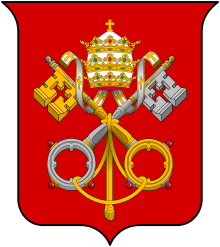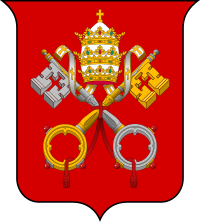Swiss Guard
The Pontifical Swiss Guard (also Papal Swiss Guard or simply Swiss Guard; Latin: Pontificia Cohors Helvetica;[2] Italian: Guardia Svizzera Pontificia; German: Päpstliche Schweizergarde; French: Garde suisse pontificale; Romansh: Guardia svizra papala) is a minor armed forces and honour guards unit maintained by the Holy See that protects the Pope and the Apostolic Palace, serving as the de facto military of Vatican City. Established in 1506 under Pope Julius II, the Pontifical Swiss Guard is among the oldest military units in continuous operation.[3]
| Pontifical Swiss Guard | |
|---|---|
| Latin: Pontificia Cohors Helvetica Italian: Guardia Svizzera Pontificia German: Päpstliche Schweizergarde French: Garde suisse pontificale Romansh: Guardia svizra papala | |
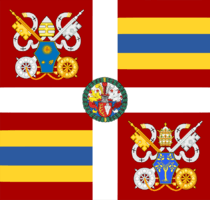 Banner of the Pontifical Swiss Guard of Pope Francis under the command of Christoph Graf (2015 to present)[1] | |
| Active | 22 January 1506 – present (514 years) |
| Country | |
| Allegiance | The Pope |
| Branch | Army |
| Type | Infantry guards |
| Role | Close protection |
| Size | 135 men |
| Garrison/HQ | Vatican City |
| Patron | |
| Motto(s) | "Acriter et Fideliter" Fiercely and Faithfully |
| Colours | Red, yellow & blue |
| Engagements | |
| Commanders | |
| Ceremonial Chief | Pope Francis |
| Commander of the Pontifical Swiss Guard | Christoph Graf |
| Vice Commander | Philippe Morard |
The dress uniform is of blue, red, orange and yellow with a distinctly Renaissance appearance. The modern guard has the role of bodyguard of the Pope. The Swiss Guard are equipped with traditional weapons, such as the halberd, as well as with modern firearms. Since the failed assassination attempt on Pope John Paul II in 1981, a much stronger emphasis has been placed on the Guard's non-ceremonial roles, and has seen enhanced training in unarmed combat and small arms.
Recruits to the guards must be unmarried Swiss Catholic males between 19 and 30 years of age who have completed basic training with the Swiss Armed Forces.[4]
The unit's security mission is assisted by the Corps of Gendarmerie of Vatican City.
History
Italian Wars
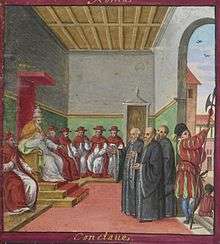
.tiff.jpg)
The Pontifical Swiss Guard has its origins in the 15th century. Pope Sixtus IV (1471–1484) had already made an alliance with the Swiss Confederacy and built barracks in Via Pellegrino after foreseeing the possibility of recruiting Swiss mercenaries. The pact was renewed by Innocent VIII (1484–1492) in order to use them against the Duke of Milan. Alexander VI (1492–1503) later actually used the Swiss mercenaries during their alliance with the King of France. During the time of the Borgias, however, the Italian Wars began in which the Swiss mercenaries were a fixture in the front lines among the warring factions, sometimes for France and sometimes for the Holy See or the Holy Roman Empire. The mercenaries enlisted when they heard King Charles VIII of France was going to war with Naples. Among the participants in the war against Naples was Cardinal Giuliano della Rovere, the future Pope Julius II (1503–1513), who was well acquainted with the Swiss, having been Bishop of Lausanne years earlier.
The expedition failed, in part thanks to new alliances made by Alexander VI against the French. When Cardinal della Rovere became Pope Julius II in 1503, he asked the Swiss Diet to provide him with a constant corps of 200 Swiss mercenaries. This was made possible through the financing of the German merchants from Augsburg, Bavaria, Ulrich and Jacob Fugger, who had invested in the Pope and saw it fit to protect their investment.[6]
In September 1505, the first contingent of 150 soldiers started their march towards Rome, under the command of Kaspar von Silenen, and entered the city on 22 January 1506, today given as the official date of the Guard's foundation.[7][8]
"The Swiss see the sad situation of the Church of God, Mother of Christianity, and realize how grave and dangerous it is that any tyrant, avid for wealth, can assault with impunity, the common Mother of Christianity," declared Huldrych Zwingli, a Swiss Catholic who later became a Protestant reformer. Pope Julius II later granted them the title "Defenders of the Church's freedom".[9]
The force has varied greatly in size over the years and has even been disbanded. Its most significant hostile engagement was on 6 May 1527, when 147 of the 189 Guards, including their commander, died fighting the troops of Holy Roman Emperor Charles V in the stand of the Swiss Guard during the Sack of Rome in order to allow Clement VII to escape through the Passetto di Borgo, escorted by the other 42 guards. The last stand battlefield is located on the left side of St Peter's Basilica, close to the Campo Santo Teutonico (German Graveyard). Clement VII was forced to replace the Swiss Guard by a contingent of 200 German mercenaries (Custodia Peditum Germanorum). Ten years later, under Pope Paul III, the Swiss Guard was reinstated, under commander Jost von Meggen.
Early modern history
After the end of the Italian Wars, the Swiss Guard ceased to be used as a military combat unit in the service of the pope and its role became mostly that of the protection of the person of the pope and of a ceremonial guard. However, twelve members of the Pontifical Swiss Guard of Pius V served as part of the Swiss Guard of admiral Marcantonio Colonna in the Battle of Lepanto in 1571.[10]
The office of commander of the Papal Guard came to be a special honour in the Catholic part of the Swiss Confederacy. It became strongly associated with the leading family of Lucerne, Pfyffer von Altishofen. Between 1652 and 1847, nine out a total of ten commanders were members of this family (the exception being Johann Kaspar Mayr von Baldegg, also of Lucerne, served 1696–1704).
In 1798, commander Franz Alois Pfyffer von Altishofen went into exile with the deposed Pius VI. After the death of the pope on 29 August 1799, the Swiss Guard was disbanded and only reinstated by Pius VII in 1801. In 1808, Rome was again captured by the French and the guard was disbanded again. Pius VII was exiled to Fontainebleau. The guard was reinstated under the same commander, Karl Leodegar Pfyffer von Altishofen, when the pope returned from exile in 1814.
Modern history
The guard was disbanded yet again in 1848, when Pius IX fled to Gaeta, but was reinstated when the pope returned to Rome in the following year.
In the later 19th century, the Swiss Guard declined into a purely ceremonial body with low standards. Guards in the Vatican were "Swiss" only in name, mostly born in Rome to parents of Swiss descent and speaking the Roman Trastevere dialect. The guards were trained solely for ceremonial parade, kept only a few obsolete rifles in store and wore civilian dress when drilling or in barracks. Administration, accommodation, discipline and organization were neglected and the unit numbered only about 90 men out of an authorized establishment of 133.[11]
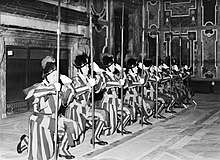
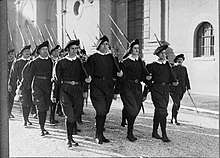
The modern Swiss Guard is the product of the reforms pursued by Jules Repond, commander during 1910–1921. Repond proposed to recruit only native citizens of Switzerland and he introduced rigorous military exercises. He also attempted to introduce modern arms, but Pius X only permitted the presence of firearms if they were not functional. Repond's reforms and strict discipline were not well received by the corps, culminating in a week of open mutiny in July 1913 and the subsequent dismissal of thirteen ringleaders from the guard.[12]
In his project to restore the Swiss Guard to its former prestige, Repond also dedicated himself to the study of historical costume, with the aim of designing a new uniform that would be both reflective of the historical Swiss costume of the 16th century and suited for military exercise. The result of his studies was published as Le costume de la Garde suisse pontificale et la Renaissance italienne (1917). Repond designed the distinctive Renaissance-style uniforms still worn by the modern Swiss Guard. The introduction of the new uniforms was completed in May 1914.
The foundation of Vatican City as a modern sovereign state was negotiated in the Lateran Treaty of 1929. The duties of protecting public order and security in the Vatican lay with the Papal Gendarmerie Corps, while the Swiss Guard, the Palatine Guard and the Noble Guard served mostly ceremonial functions. The Palatine and Noble Guards were disbanded by Paul VI in 1970, leaving the Swiss Guard as the only ceremonial guard unit of the Vatican. At the same time, the Gendarmerie Corps was transformed into a Central Security Office, with the duties of protecting the Pope, defending Vatican City, and providing police and security services within its territory, while the Swiss Guard continued to serve ceremonial functions only. Paul VI in a decree of 28 June 1976 defined the nominal size of the corps at 90 men. This was increased to 100 men by John Paul II on 5 April 1979. As of 2010 the guard numbered 107 halberdiers divided into three squads, plus five officers.[13]
_(5994412883).jpg)
Since the assassination attempt on John Paul II of 13 May 1981, a much stronger emphasis has been placed on the guard's non-ceremonial roles.[14] The Swiss Guard has developed into a modern guard corps equipped with modern small arms, and members of the Swiss Guard in plain clothes now accompany the pope on his travels abroad for his protection.
On 4 May 1998 commander Alois Estermann was murdered on the day of his promotion. Estermann and his wife, Gladys Meza Romero, were killed by the young guardsman Cédric Tornay, who later committed suicide. The case received considerable public attention and became the subject of a number of conspiracy theories involving either Cold War politics or the Opus Dei controversy. British journalist John Follain who published a book on the case in 2006 concluded that the killer acted purely on personal motivation.[15]
On the occasion of the 500th anniversary of the Swiss Guard, in April–May 2006, 80 former guardsmen marched from Bellinzona in southern Switzerland to Rome, recalling the march of the original 200 Swiss guards to take up Papal service, in 1505. The march had been preceded by other celebrations in Lucerne, including a rally of veterans of the Guard and a Mass.[16] In a public ceremony on 6 May 2006, 33 new guards were sworn in on the steps of St. Peter's Basilica instead of the traditional venue in the San Damaso Courtyard. The date chosen marked the anniversary of the Sack of Rome when the Swiss Guard had been nearly destroyed. Present at this event were representatives of the Company of Pikemen and Musketeers of the Honourable Artillery Company of London and the Ancient and Honorable Artillery Company of Massachusetts.
In December 2014, Pope Francis directed that Daniel Anrig's term as commander should end on 31 January 2015, being replaced by his deputy Christoph Graf. This followed reports about Anrig's "authoritarian style".[17]
With the rise of Islamic terrorism in Europe and open threats against the Vatican issued by the Islamic State (ISIS), Vatican officials in 2015 collaborated with Italian authorities to improve the protection of Vatican City against attacks that cannot be reasonably defended against by the Swiss Guard and Vatican police, notably against drone attacks.[18]
Recruitment and service
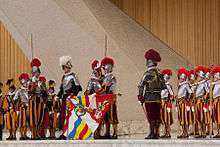
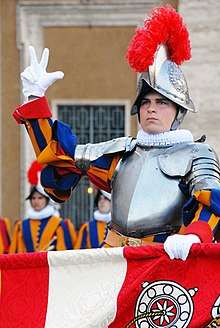
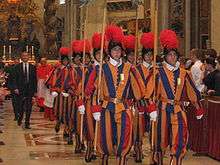
Recruits to the guards must be Catholic, single males with Swiss citizenship who have completed basic training with the Swiss Armed Forces and can obtain certificates of good conduct. Recruits must have a professional degree or high school diploma and must be between 19 and 30 years of age and at least 174 cm (5 ft 8.5 in) tall.[4] In 2009, the Pontifical Swiss Guard commandant, Daniel Anrig, suggested that the Guard might someday be open to recruiting women, but he added that the admission of female recruits remained far in the future.[19]
Qualified candidates must apply to serve. If accepted, new guards are sworn on 6 May every year in the San Damaso Courtyard (Italian: Cortile di San Damaso) in the Vatican (6 May is the anniversary of the Sack of Rome). The chaplain of the guard reads aloud the oath in the languages of the guard (German, Italian, and French):[20][21]
(English translation) I swear that I will faithfully, loyally and honourably serve the Supreme Pontiff (name of pope) and his legitimate successors, and dedicate myself to them with all my strength, sacrificing, if necessary, my life to defend them. I assume this same commitment with regard to the Sacred College of Cardinals whenever the Apostolic See is vacant. Furthermore, I promise to the Commanding Captain and my other superiors respect, fidelity and obedience. I swear to observe all that the honour of my position demands of me.
When his name is called, each new guard approaches the Pontifical Swiss Guard's flag, grasping the banner in his left hand. He raises his right hand with his thumb, index, and middle finger extended along three axes, a gesture that symbolizes the Holy Trinity, and swears in his native tongue:
(German version) Ich schwöre, alles das, was mir soeben vorgelesen wurde, gewissenhaft und treu zu halten, so wahr mir Gott und seine Heiligen helfen.[22]
(Italian version) Giuro d’osservare fedelmente, lealmente e onorevolmente tutto ciò che in questo momento mi è stato letto, che Iddio e i Suoi Santi mi assistano.[22]
(French version) Je jure d’observer, loyalement et de bonne foi, tout ce qui vient de m’être lu aussi vrai que Dieu et ses Saints m’assistent.[22]
(English translation) I swear to diligently and faithfully abide by all that has just been read out to me, so help me God and his Saints.
"Those who are accepted serve for a minimum of two years, but can also stay in service for an additional year or two, which was the case for many guards during the "Jubilee of Mercy" in 2015.[23] Regular guardsmen (halberdiers) receive a tax-free salary of EUR 1,300 per month (as of 2015) plus extra pay for hours worked overtime. In addition, accommodation and boarding are provided.[24] Members of the guard are eligible for Vatican decorations. The Benemerenti medal is usually awarded after three years of faithful service.
Uniforms
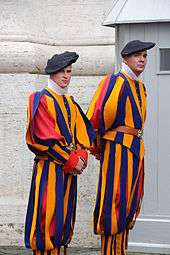
The official full dress uniform is of blue, red, orange and yellow with a distinctly Renaissance appearance. It was introduced by commandant Jules Repond (1910–1921) in 1914.[25] Repond's design was inspired by 16th-century depictions of the Swiss Guard.
While both Michelangelo and a painting of the Pontifical Swiss Guard bearing Pope Julius II on a litter (by Raphael) are often cited as inspiration for the Pontifical Swiss Guard uniform,[25] the actual uniforms worn by those soldiers included a flaring skirt;[26] a common feature in male clothing during the Renaissance.
A clear expression of the modern Pontifical Swiss Guard uniform can be seen in a 1577 fresco by Jacopo Coppi of the Empress Eudoxia conversing with Pope Sixtus III. It shows the precursor of today's recognisable three-colored uniform with boot covers, white gloves, a high or ruff collar, and either a black beret or a black Comb morion (silver for high occasions). Sergeants wear a black top with crimson leggings, while other officers wear an all-crimson uniform.
The colors blue and yellow were in use from the 16th century, said to be chosen to represent the Della Rovere coat of arms of Julius II, with the colour red added to represent the Medici coat of arms of Leo X.
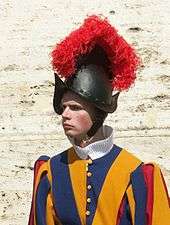
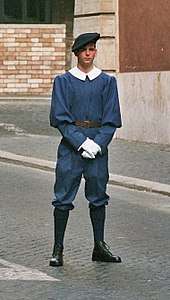
The ordinary guardsmen and the sub-corporals wear the "tricolor" (yellow, blue and red) uniform without any rank distinctions except for a different model of halberd in gala dress. The corporals have red braid insignia on their cuffs and use a different, more spear-like, halberd.
Headwear is typically a black beret for daily duties, while a black or silver morion helmet with red, white, yellow, black, and purple ostrich feathers is worn for ceremonial duties, the former for guard duty or drill; the latter for high ceremonial occasions such as the annual swearing-in ceremony or reception of foreign heads of state. Historically brightly coloured pheasant or heron feathers were used.[27] The senior non-commissioned and warrant officers have a different type of uniform. All sergeants have essentially the same pattern of dress as ordinary guardsmen, but with black tunics and red breeches. Every sergeant has a red plume on his helmets, except for the sergeant major, who displays distinctive white feathers. When the gala uniform is worn, sergeants have a different pattern of armor with a gold cord across the chest.
The commissioned officers (captains, major, vice-commander and commander) are distinguished by a completely red uniform with a different style of breeches, and golden embroidery on the sleeves. They have a longer sword, which is used when commanding a group or a squadron of guards. In gala dress all ranks use a bigger purple plume on their helmets, except for the commander, who has a white one. Usually the commander and the chief of staff (usually the vice-commander) use armor when present at gala ceremonies. On such occasions "armor complete" – including sleeve armor, is worn. Except for ceremonial occasions and exercises, officers of the guard wear civilian dress when on duty.[13]
The tailors of the Swiss Guard work inside the Vatican barracks. There the uniform for each guardsman is tailor-made individually.[28] The total set of Renaissance style clothing weighs 8 pounds (3.6 kg), and may be the heaviest and most complicated uniform in use by any standing army today. A single uniform requires 154 pieces and takes nearly 32 hours and 3 fittings to complete.[29]
The modern regular duty service dress uniform is more functional, consisting of a simpler solid blue version of the more colorful tricolor grand gala uniform, worn with a simple brown belt, a flat white collar and a black beret.[25] For new recruits and rifle practice, a simple light blue overall with a brown belt may be worn. During cold or inclement weather, a dark blue cape is worn over the regular uniform.
In 2019, after more than 500 years, the Swiss Guard will receive new and modernized helmets. The old metal helmet has been replaced by a 21st century high-tech, 3D-printed version, made of UV-resistant PVC, a common type of plastic. The new helmets will have hidden air vents to better keep the guards cool in the warm Roman sun. The new design was created by engineer Peter Portmann and Swiss firm 3D-Prototyp, by scanning the 16th century original to create a model which was then molded in PVC and painted with a water-based, UV resistant paint. It now takes just one day to make a helmet, whereas the metal model took several days.[30]
Equipment

The eponymous main weapon of the halbardiers is the halberd; corporals and vice-corporals are equipped with a partisan polearm. Ranks above corporal do not have polearms, but on certain ceremonial occasions carry command batons. The banner is escorted by two flamberge great swords carried by corporals or vice-corporals. A dress sword is carried by all ranks, swords with a simple S-shaped crossguard by the lower ranks, and elaborate basket-hilt rapiers in the early baroque style by officers.
Arms and armour used by the Swiss Guard are kept in the Armeria (armoury). The Armeria also contains a collection of historical weapons no longer in use.[31][32] The armoury preserves a collection of historical plate armour (cuirasses or half-armour). The oldest specimens date to c. 1580, while the majority originates in the 18th century. Historical armour was worn on the occasion of canonizations until 1970, since 1970 their use has been limited to the oath ceremony on 6 May. A full set of replicas of the historical cuirasses was commissioned in 2012, from Waffen und Harnischschmiede Schmidberger in Molln, Upper Austria in 2012. The cuirasses are handmade, and the production of a single piece takes about 120 hours.[33] The replicas are not financed by the Vatican itself but by private donations via the Foundation for the Swiss Guard in the Vatican, a Fribourg-based organisation established in 2000.[34]
The Swiss Guard in their function as bodyguards are equipped with the SIG Sauer P220 pistol and the SIG SG 550 rifle (or its SG 552 variant) also in use by the Swiss Army. As recruits to the Swiss Guard must have passed basic military training in Switzerland, they are already familiar with these weapons when they begin their service. The pepper spray used by the Swiss Army (RSG-2000) is also in use. The Glock 19 pistol and Heckler & Koch MP7 submachine gun are reportedly also carried by Swiss Guard members in their function as plainclothes bodyguards.[35]
In the 19th century (prior to 1870), the Swiss Guard along with the Papal Army used firearms with special calibres such as the 12.7 mm Remington Papal.[36] The Swiss Guard historically also used the M1842 T.59-67, 1871 Vetterli, Schmidt-Rubin K31 and SIG SG 510 rifles, the Dreyse M1907 pistol, and the SIG MKMO, Hispano-Suiza MP43/44 and Heckler & Koch MP5 submachine guns.[35]
Ranks and insignia
- Commissioned officers
- Oberst (Colonel – the commandant of the Guard)
- Oberstleutnant (Lieutenant Colonel – the vice-commandant)
- Kaplan (Chaplain – considered the same rank as a lieutenant colonel)
- Major
- Hauptmann (Captain)
- Non-commissioned officers
- Feldweibel (Sergeant-major)
- Wachtmeister (Sergeant)
- Korporal (Corporal)
- Vizekorporal (Vice-corporal; closest British equivalent would be lance corporal)
- Enlisted
- Hellebardier/Gardist (Halbardier/Guardsman)
Table of shoulder marks worn by officers.
| Equivalent NATO Code | OF-10 | OF-9 | OF-8 | OF-7 | OF-6 | OF-5 | OF-4 | OF-3 | OF-2 | OF-1 | OF(D) & Student officer | |||||||||||||||||||||||||
|---|---|---|---|---|---|---|---|---|---|---|---|---|---|---|---|---|---|---|---|---|---|---|---|---|---|---|---|---|---|---|---|---|---|---|---|---|
(Edit) |
No equivalent |
_Pontifical_Swiss_Guard.svg.png) |
_Pontifical_Swiss_Guard.svg.png) |
_Pontifical_Swiss_Guard.svg.png) |
_Pontifical_Swiss_Guard.svg.png) |
No equivalent | ||||||||||||||||||||||||||||||
| Oberst | Oberstleutnant | Major | Hauptmann | |||||||||||||||||||||||||||||||||
Table of sleeve insignia worn by other ranks.
| Equivalent NATO code | OR-9 | OR-8 | OR-7 | OR-6 | OR-5 | OR-4 | OR-3 | OR-2 | OR-1 | |||||||||||||||||||||||||||
|---|---|---|---|---|---|---|---|---|---|---|---|---|---|---|---|---|---|---|---|---|---|---|---|---|---|---|---|---|---|---|---|---|---|---|---|---|
(Edit) |
No equivalent |
 |
No equivalent |  |
 |
 |
No equivalent |  | ||||||||||||||||||||||||||||
| Feldweibel | Wachtmeister | Korporal | Vizekorporal | Hellebardier | ||||||||||||||||||||||||||||||||
Table of cap badges worn on berets and other headdress.
| Colonel (Oberst) | Lieutenant Colonel (Oberstleutnant) | Major (Major) | Captain (Hauptmann) | Sergeant Major (Feldweibel) | Sergeant (Wachtmeister) | Corporal (Korporal) | Vice Corporal (Vizekorporal) |
|---|---|---|---|---|---|---|---|
| 1 | 1 (+ Chaplain) | 1 | 2 | 1 | 5 | 10 | 10 |
 |
 |
 |
 |
 |
 |
 |
 |
Banner
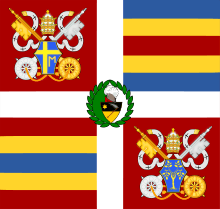

The design of the banner of the Pontifical Swiss Guard banner has been changed several times. A fresco by Polidoro da Caravaggio in the burial chapel of the guard in Santa Maria della Pietà in Campo Santo Teutonico, commissioned by the second commander, Marx Röist, in 1522, depicts the commander of the guard flanked by two banners. An early reference to the guard's banner (vennly) dates to 1519, although the design of that banner is unknown. An early surviving banner is on display in the Sala Regia. The banner would change with each pontificate, and depict the colours of the coat of arms of the reigning pope. The modern colours of the Swiss Guard, introduced in the early 20th century, are those of the House of Medici, first used under the Medici popes and depicted in a fresco by Giuseppe Porta (1520–1575).[38] Under Pius IX (Mastai Ferretti, r. 1846-1878), it was divided into three horizontal fields, displaying the coat of arms of the Holy See (keys in saltire surmounted by the papal tiara on a red field), the Swiss flag (a white cross with two laurel branches on a red field) and a yellow field without heraldic charge. On the reverse side of the banner was the papal coat of arms of Pius IX. Under Pius X (Giuseppe Melchiorre, r. 1903–1914) and commander Leopold Meyer von Schauensee (1901–1910), the top field displayed the papal coat of arms in a blue field, in the center field was red without heraldic charge and the bottom field displayed the family coat of arms of the guard commander.[39]
The modern design of the banner was first used under commander Jules Repond of Freiburg (1910–1921).[40] The modern banner is a square divided by a white cross into quarters (in the tradition of the banners historically used by the Swiss Guards in the 18th century). In the fourth quarter (lower right) is Pope Julius II's coat of arms; in the first quarter (upper left) that of the reigning Pope. The other two quarters display the Swiss Guard's colours (red, yellow and blue, the colours of the House of Medici), and in the center of the cross is the commander's own coat of arms. The current banner (As of 2016) thus shows the coat of arms of Pope Francis in the first quarter and a vignette of the family coat of arms of Christoph Graf in the center. It has dimensions of 2.2 m squared, woven in a damask pattern of pomegranates and thistles, in what is known as "Julius-damask" based on the Julius banners of 1512. The central vignette is embroidered on the backdrop of the colours of the flag of Lucerne. The guard colours in the second quarter (upper right) were reversed so that the second and third quarters are identical. The banner was completed in April 2015, and it was first used for the oath of service of new recruits on 6 May 2015.[1]
Even though the banner is carried out during ceremonies and the Urbi et Orbi address and blessing twice a year, during the current term of Pope Francis, only the Flag of Vatican City is used instead of the banner during ceremonial occasions as a sort of national colour whenever the Pope is present.
See also
- Swiss Guards
- Papal Army
- Military of Vatican City
- Noble Guard (Vatican)
- Palatine Guard
- Corsican Guard
- Papal Zouaves
- Corps of Gendarmerie of Vatican City
References
- Werner Affentranger, Fahne Gardekommandant Graf (Gardefahne) (Maa 2015). The banner colonel Graf was completed in April 2015. Its central vignette displays the family coat of arms of Graf of Pfaffnau, "gules a plowshare argent and antlers or". WH 1/396.1 Familienwappen \ Familie: Graf \ Heimatgemeinden: Altbüron, Dagmersellen, Pfaffnau, Schötz, Triengen (State Archives of Lucerne).
- https://www.vatican.va/news_services/press/documentazione/documents/sp_ss_scv/informazione_generale/guardia-svizzera_it.html
- The Swiss Guard has been repeatedly disbanded, most notably for a twenty-year period during 1527–1548, and briefly in 1564/5, in 1798/9 and during 1808–1814. "Spotlight on the Swiss Guard". news.va. Retrieved 8 February 2015. Extant units of comparable age include the English Yeomen of the Guard, established in 1485, and the 1st King's Immemorial Infantry Regiment of AHQ of the Spanish Army (Regimiento de Infantería "Inmemorial del Rey" nº 1). "Regimiento de Infantería "Inmemorial del Rey" nº 1". Ejército de Tierra - Ministerio de Defensa - España. Retrieved 6 December 2014.
- Admission requirements Official Vatican web page, Roman Curia, Swiss Guards, retrieved 7 August 2006
- "Suisse en Cuirasse", G. Perugini Costumes de la cour de Rome (1852), pl. 42.
- Pölnitz, Götz Freiherr von (6 May 2018). Jakob Fugger: Quellen und Erläuterungen. Mohr Siebeck. ISBN 9783168145721 – via Google Books.
- Peter Quardi: Kaspar von Silenen in German, French and Italian in the online Historical Dictionary of Switzerland, 2011.
- McCormack, John (1 September 1993). One Million Mercenaries: Swiss Soldiers in the Armies of the World. Pen and Sword. ISBN 9781473816909. Retrieved 21 January 2016.
- History of the Pontifical Swiss Guards Official Vatican web page, Roman Curia, Swiss Guards, retrieved on 7 August 2006.
- Alois Lütolf, Die Schweizergarde in Rom: Bedeutung und Wirkungen im sechszehnten Jahrhundert : nebst brieflichen Nachrichten zur Geschichte jenes Zeitalters von den Gardeofficieren (1859), p. 78.
- Alvarez, David (2011). The Pope's Soldiers. p. 285. ISBN 978-0-7006-1770-8.
- Alvarez, David (2011). The Pope's Soldiers. pp. 288–290. ISBN 978-0-7006-1770-8.
- Alvarez, David (2011). The Pope's Soldiers. p. 368. ISBN 978-0-7006-1770-8.
- Alvarez, David (2011). The Pope's Soldiers. p. 365. ISBN 978-0-7006-1770-8.
- John Follain, City of Secrets: The Truth behind the murders at the Vatican (2006).
- BBC News, Sunday 22 January 2006
- "Pope Francis dismisses 'authoritarian' Swiss Guard commander". BBC News. Retrieved 3 December 2014.
- Swiss Guard Commander on ISIS Threat to Pope: ‘We Are Ready to Intervene’, National Catholic Register, 24 February 2015. "Vatican on alert for Islamic State attacks against Pope Francis", Reuters, 3 March 2015. Eric J. Lyman, Protecting Vatican from terrorists is an 'enormous' challenge, USA Today, 29 November 2015. Andrew Woods, In Defence of His Holiness: the Pontifical Swiss Guard and the Islamic State, Foreign Affairs Review, 1 December 2015.
- "Pope thanks Pontifical Swiss Guard for dedicated, loyal service", Catholic News Service, 7 May 2009
- "May 6th: The Recruits Take their Oath of Loyalty". Vatican - The Holy See. Retrieved 26 April 2012.
- "Swearing-in". Swissguard.va. Holy See. Missing or empty
|url=(help) - "Formula del Giuramento (Oath of Loyalty)" (in German, French, and Italian). Vatican - The Holy See. Retrieved 4 January 2013.
- "The Swiss Guard is more than an army – it's a school of faith". ewtnnews.com.
- "Interview with a Papal Swiss Guard". themosttraveled.com. Archived from the original on 8 February 2015. Retrieved 8 February 2015.
- "The Pontifical Swiss Guard – Uniforms". The Vatican. Retrieved 2011-04-17.
- Preben Kannik, plate 1 "Military Uniforms of the World", SBN 71370482 9
- "The Swiss Guard - The Uniform of the Swiss Guards". vatican.va. Retrieved 8 February 2015.
- "Archived copy". Archived from the original on 2013-07-18. Retrieved 2017-08-15.CS1 maint: archived copy as title (link)
- National Geographic: Inside the Vatican,2001
- Gallagher, Della (January 24, 2019). "Vatican's Swiss Guards wear new 3D-printed helmets". CNN. Retrieved June 22, 2020.
- Chris Eger (16 April 2017). "Guns of the Vatican's Swiss Guard". Guns.com. Retrieved 31 August 2017.
- Tyler Rogoway (28 September 2015). "The Pope Has A Small But Deadly Army Of Elite Warriors Protecting Him". Foxtrot Alpha. Retrieved 31 August 2017.
- Harald Pöcher, Österreichische Waffen für die Schweizergarde DER SOLDAT 15/2012. Johanna Wedl Rüstungen für Schweizer Garde NZZ 16 February 2013.
- Harnischreplikate Fondazione GSP (guardiasvizzera.va), 2013.
- Chris Eger, Guns of the Swiss Guard (guns.com) 13 April 2014.
- 12,7 mm Remington Papal (patronensammlervereinigung.at); see also earmi.it database.
- John Woodward, A Treatise On Ecclesiastical Heraldry (1894), p. 161.
- Die Fahne der Päpstlichen Schweizergarde (kath.net), 4 May 2015.
- Stefan Vogler, Sacco di Roma; Plünderung von Rom (2015), p. 19.
- Gardefahnen der Schweizergarde (vaticanhistory.de)
Sources
- Alvarez, David. The Pope's Soldiers: A Military History of the Modern Vatican. University Press of Kansas, 2011.
- Richard, Christian-Roland Marcel. La Guardia Svizzera Pontificia nel corso dei secoli. Leonardo International, 2005.
- Royal, Robert. The Pope's Army: 500 Years of the Papal Swiss Guard. Crossroads Publishing Co, 2006.
- Roland Beck-von Büren: Päpstliche Schweizergarde in German, French and Italian in the online Historical Dictionary of Switzerland, 2005-08-29.
- Serrano, Antonio. Die Schweizergarde der Päpste. Verlagsanstalt, Bayerland, 1992.
External links
| Wikimedia Commons has media related to Pontifical Swiss Guards. |
- Official website: English
- Official website: German
- Official website: French
- Official website: Italian
- The Vatican's Official Swiss Guard site
- Pontifical Swiss Guard, Commission or Committee of the Roman (CuriaGCatholic.org)
- Five Hundred Years of Loyalty (catholicism.org)
- Insignia of Rank (officers and other ranks) Pontifical Swiss Guard (uniforminsignia.com)
